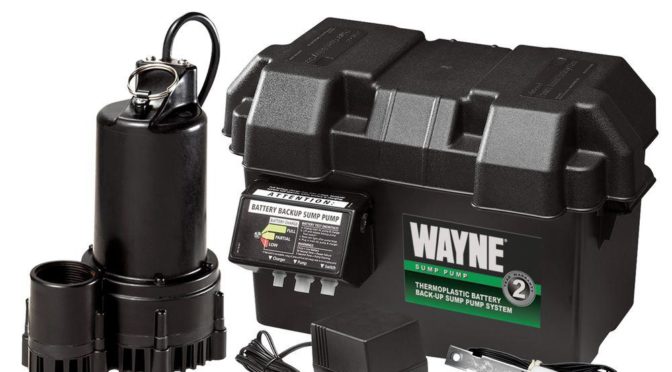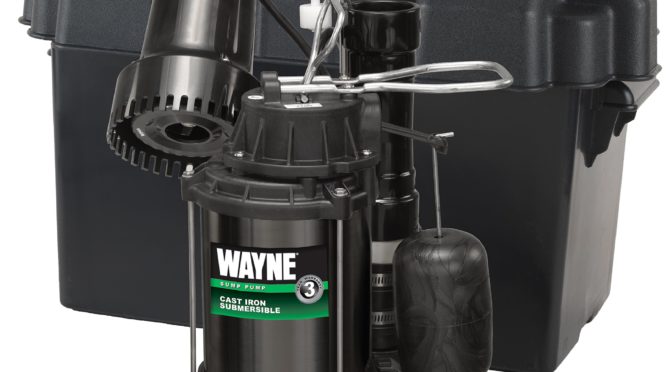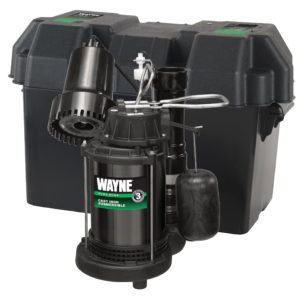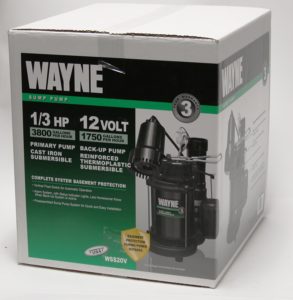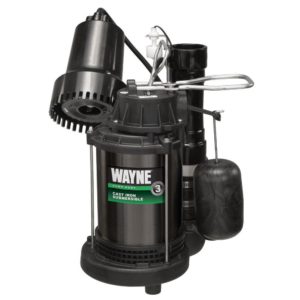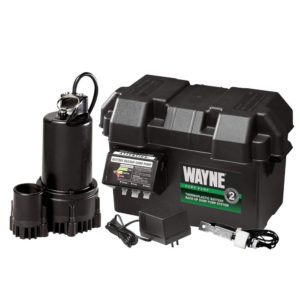 One of the most frequent questions we get from homeowners interested in sump pump installation is whether or not backup sump pumps are worth it or not. We’re firm believers that they are, and we always recommend them whenever installing new sump pumps; the peace of mind is priceless, while the actual additional cost is as little as a couple hundred dollars over that of an AC sump pump. As a result, we frequently suggest combination systems like the Wayne WSS30V and the Wayne WSS20V. However, what do you do if you already have an AC sump pump you like and don’t want to replace it just because you’d like a battery backup system?
One of the most frequent questions we get from homeowners interested in sump pump installation is whether or not backup sump pumps are worth it or not. We’re firm believers that they are, and we always recommend them whenever installing new sump pumps; the peace of mind is priceless, while the actual additional cost is as little as a couple hundred dollars over that of an AC sump pump. As a result, we frequently suggest combination systems like the Wayne WSS30V and the Wayne WSS20V. However, what do you do if you already have an AC sump pump you like and don’t want to replace it just because you’d like a battery backup system?
This is where the Wayne ESP25 12 Volt Battery Back Up Sump Pump System comes in. For a little over $200, or the cost of a great primary sump pump like the WDU980E, you can get a battery-powered backup sump pump that will take over when your main AC pump stops due to a power outage. We’ve already reviewed the ESP25 when working in concert with the WDU800 (together they make up the WSS30V); let’s look at how it works by itself. If you’re ready to buy and just want confirmation that it’s the right decision, then yes, we recommend it for any household looking for a battery backup to an existing functional primary pump. You can buy the ESP25 here.
Key Features of the Wayne ESP25 Sump Pump (60 Second Summary)
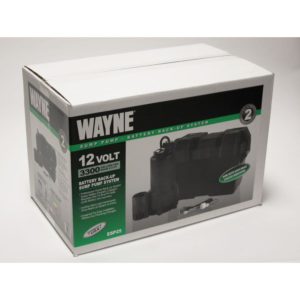 The Wayne ESP25 is a battery backup submersible sump pump system. The pump is DC-powered and features a 12 volt motor. It features a 3,300 gallon per hour maximum water flow rate and a 2 year limited warranty . It’s just under 11″ tall, 16.3″ wide, and just under 9″ deep with a maximum pumping height of 15 feet and a switch-on/switch-off height of 4″ and 9″ respectively. The aforementioned pump switch is vertical.
The Wayne ESP25 is a battery backup submersible sump pump system. The pump is DC-powered and features a 12 volt motor. It features a 3,300 gallon per hour maximum water flow rate and a 2 year limited warranty . It’s just under 11″ tall, 16.3″ wide, and just under 9″ deep with a maximum pumping height of 15 feet and a switch-on/switch-off height of 4″ and 9″ respectively. The aforementioned pump switch is vertical.
The ESP25 doesn’t use AC; it’s a DC battery backup, although the battery isn’t included; you’ll need a 12 volt deep cycle battery with either 40 amp hours or 75 amp hours. It weighs 16.3 pounds. Although the discharge flow can reach 3,300 gallons per hour at 0 feet, it drops to 2,300 gallons per hour at 10 feet, 1,500 gallons per hour at 15 feet, and is inoperative at 20 feet.
The working temperature spans 33-120 degrees Fahrenheit, it’s self-priming and housed in thermoplastic, and the sump pump outlet diameter is 1-1/2″ FPT. It’s designed to be used with sump pits (sump basins) at least 15 inches in diameter.
How Does the Wayne ESP25 Compare to the WSS30V Sump Pump?
The most important difference to keep in mind between the ESP25 and the WSS30V is that the ESP25 does not include the AC-powered CDU800. The WSS30V can do everything the ESP25 does and more, as it’s two pumps (the CDU800 and the ESP25) in one unit. As a result, the ESP25 cannot be plugged in, and the pump is not designed to be installed as a standalone device; you’ll need an already-installed AC sump pump in your sump basin to keep your basement dry. The reason behind this is that a brand new, fully charged battery will run down in around 2-4 days of round the clock use. If you don’t have a functional AC-powered sump pump, you’ll either want to buy a separate one (we recommend the Wayne CDU980E as the best sump pump under $200) or a combined AC-DC unit (we recommend the Wayne WSS30V as the best combination sump pump under $400).
Our Short and Long Term Experiences Installing and Using the Wayne ESP25 Sump Pump
Installing the ESP25 was straightforward and without any unforeseen complications (keeping in mind that we do this on a daily basis). The supplied instruction manual is accurate enough, but it’s also quite general and contains a lot of information that won’t necessarily apply to the ESP25, so it’s best to use it as a benchmark rather than as a step-by-step guide to installation.
Being a backup pump, you ideally won’t hear the ESP25 going off except in dire situations (i.e., when the power has failed and you’re experiencing heavy rainfall threatening to overspill your sump basin). However, we’re happy to note that it’s an effective little beast at pumping water out; most of the families for whom we’ve installed it have given us positive long term feedback, with a number of homeowners stating they’ve had trouble-free experiences for more than 4 years (aside from changing the battery). It’s also a very quiet sump pump and effectively inaudible once you’re more than a few feet away.
There’s a small alarm that sounds whenever the ESP25 is activated, which is theoretically only during power failures. It’s a nice alarm because it can serve as a reminder to check the ESP25 to make sure it’s indeed working the way it’s supposed to when you need it most (i.e., when your main pump isn’t working due to said power outage). It’s not as loud as we’d like it to be, but you can hear it from at least one floor above (and presumably you won’t have the TV, computer, or stereo drowning it out in sound during a power outage).
Troubleshooting and Installation Tips to Get Your Wayne ESP25 Working Sooner
It’s essential to note that for your backup pump to work, it needs a 12 volt deep cycle battery attached; if you don’t, it’s not going to work when you need it to (which is when your AC pump isn’t working due to a power outage). We recommend (and Wayne requests) you choose either a 40 or 75 amp battery; if you try to use a larger battery, you might not get it to fit in the battery box. You need a 27-frame sized battery.
Instead of choosing a regular check valve for the ESP25, we’d recommend buying a silent check valve; this is the quickest way to get rid of the “thunk!” or “clunk!” sound that frequently accompanies traditional hammer check valves whenever the sump pump turns itself off. The Brady check valve is a cheap and highly effective model. And yes, it’s absolutely silent.
Try to make it a habit to test your ESP25 at least once a month. Being a backup mechanical device buried in a hole in a basement, it’s easy to install it and forget it. However, a monthly check is the best way to make sure everything is still working the way it should, so you won’t find out through a real-life test that the sump pump fails (i.e., a heavy rainfall during a power outage while you’re on vacation). Things we’ve seen fail in the ESP25 (and in other DC-powered sump pumps) include the float switch (if it fails, the pump won’t be signaled to activate) and the battery (if it stops holding a charge, it won’t power the sump pump).
Finally, we’d recommend installing a separate water alarm. It doesn’t have to be very fancy; a basic model like the Basement Watchdog will do. The important thing is to have one installed in your sump pit slightly higher than your backup float switch. If water levels rise, the main float switch is triggered and your AC sump pump gets to work. If the power goes out, the water level rises to the backup float switch, which triggers your DC pump to work. If the DC pump doesn’t start, stops working, or simply can’t keep up with the water, then the water reaches the water alarm sensor and you know it’s time to get to the basement.
Wayne ESP25 Sump Pump’s Pros, Cons, and Value Comparison
Overall, we’re extremely pleased with the ESP25 and would recommend it to any homeowner with a functional AC powered sump pump. If you’re interested in replacing your AC pump and buying a DC backup at once, we’d recommend the WSS300V instead. Whatever you do, we absolutely recommend having a DC backup sump pump as additional basement insurance.
You can buy the Wayne ESP25 battery backup sump pump here on Amazon. You can buy the Wayne WSS30V combination sump pump here. You can buy the Wayne CDU980E sump pump here. You can buy a 75Ah backup pump battery here. You can buy a battery terminal set here. You can buy a water alarm here. You can buy a silent check valve here.
 If you find our work at PumpThatSump helpful, you can put our relentless reviewing of every pump and fixture on the market to the test by shopping via our links above for whatever you need to make your house a home. Despite being self-employed, we promise not to spend it all on health insurance.
If you find our work at PumpThatSump helpful, you can put our relentless reviewing of every pump and fixture on the market to the test by shopping via our links above for whatever you need to make your house a home. Despite being self-employed, we promise not to spend it all on health insurance.
